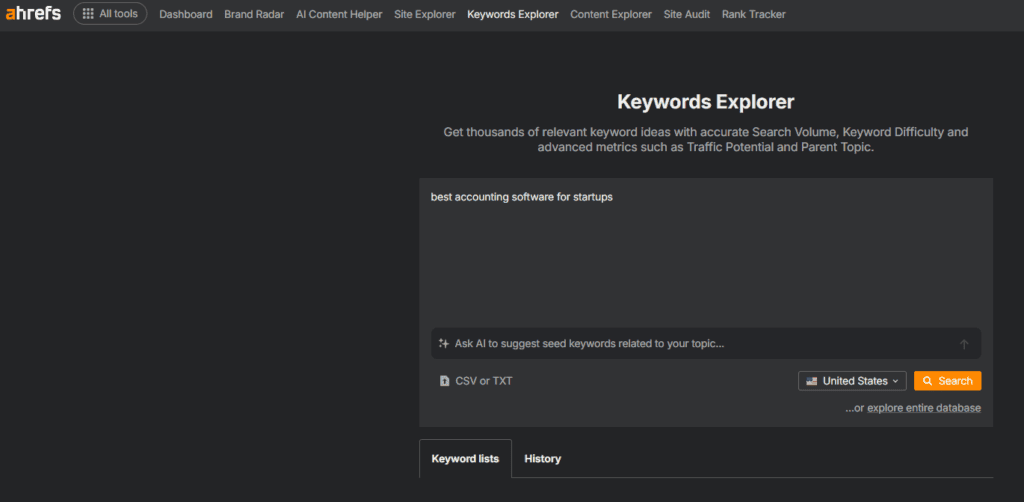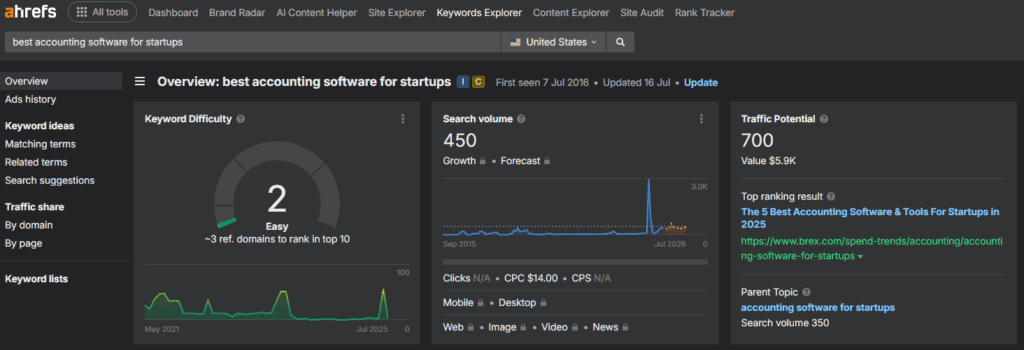How to Calculate How Many Backlinks You Need to Rank for Your Target Keyword
If a specific focus keyword is important to your bottom line, you need to develop an action plan to rank on Google. In this guide, we’ll go over how to calculate a rough estimate of the number of backlinks you need to rank for your needle-moving keywords.
We’re using Ahrefs for this article (personal preference), but other SEO software tools like SEMrush can also do the trick.
What Backlinks Signal to Google and Why They Matter
Backlinks act as “votes of confidence” from other websites, signaling to Google that your content is credible, authoritative, and worth ranking.
When high-quality, contextually relevant sites link to your pages, it tells search engines that your content is trustworthy and valuable within its niche. This can directly influence your position in search results: sites with a strong, authoritative backlink profile tend to rank higher, attract more organic traffic, and maintain long-term visibility.
Understanding the importance of backlinks, let’s explore how backlink gap analysis can uncover opportunities to enhance your site’s authority and ranking.
What is Backlink Gap Analysis?
Backlink Gap Analysis is an SEO technique used to identify backlink building opportunities by comparing your website’s backlink profile to your competitors. The goal is to discover websites that link to your competitors but not to you, giving you a targeted list of potential outreach prospects.
By conducting a thorough backlink gap analysis, you can answer the age-old question, “How many backlinks do I need?”
How to Do Backlink Gap Analysis
While it sounds like something only an expert-level SEO is capable of doing, it’s actually quite simple once you understand the processes involved.
- Identify Search Competitors: Your top competitors are typically the websites who rank in the top 3 positions on Google. While this can be your direct business competitors, that’s not always true. Search competitors can be any online entity, from industry blogs to reddit discussion threads.
- Gather Backlink Data: Using SEO tools like Ahrefs, SEMrush, and Majestic, extract a list of each search competitor’s backlink profile.
- Compare Backlink Profiles: This is how we figure out the gap between top-ranking sites and yours. The goal is to find domains linking to 1+ search competitors that haven’t yet linked to your business.
- Prioritize Potential Opportunities: Now it’s time to apply some filters to find the strongest backlink building opportunities. We’ll filter the data down to reach our standards for site authority, traffic, relevance, and overall trustworthiness.
Why Backlink Gap Analysis Matters
Backlink gap analysis tells you precisely how many backlinks you’ll need to fight on an even playing field with top-ranking search competitors. Beyond that, there are many benefits to doing even just some quick research:
- Reveals Proven Link Sources: If a site links to your competitor, it’s more likely to be open to linking to similar content.
- Saves Time: Instead of cold-pitching random websites, you focus on domains already linking in your niche. They are much more likely to convert from cold email outreach than other link prospecting methods.
- Closes Ranking Gaps: Competitors often gain SEO advantages through their backlinks; targeting the same sources can help you catch up or surpass them.
How to Estimate How Many Backlinks You Need to Rank Top 3
It’s time for the nitty-gritty. Let’s show you exactly how to estimate how many backlinks you need to rank in the top three using Ahrefs’ Keyword Explorer.
For this example, we’ll determine how many links it takes to rank for the keyword “best accounting software for startups”.

While not a terribly competitive keyword, this is a great bottom of funnel keyword that’s sure to drive conversions if you rank highly. You’ll notice in the screenshot below under Keyword Difficulty that Ahrefs estimates you’ll need 3 referring domains (unique backlinks from different websites) to rank in the top 10 for this keyword.
Sounds nice, but we want to rank in the top 3 because that’s where the bulk of clicks happen.

Let’s scroll down Ahrefs’ summary and take a look at how many backlinks the top 3.

55 links in position 1, 1 for position 2, and 15 for position 3. The top 3 positions average roughly 24 backlinks, which is our magic number.
Of course, that’s assuming we’re competing on an even playing field, meaning:
- Your website has a similar site authority (DR).
- Your website satisfies search intent just as well.
- Your website demonstrates trust signals to readers and to Google.
If you have a significantly lower site authority than the top 3 ranking websites, you’re going to need a hell of a lot more backlinks because you’re playing catch up.
If criteria 2 or 3 are lacking, you’ll need to correct these issues before investing into backlink building because it could make your efforts fruitless.
3 Ways to Build Contextually-Relevant Backlinks
When ranking for competitive keywords, securing backlinks that are contextually relevant to your niche is far more valuable than chasing high numbers alone.
Search engines prioritize links that make sense in the context of your content and industry, as these are stronger indicators of credibility and topical authority.
In other words, the quality and relevance of your backlinks often matter more than sheer volume when determining how many backlinks you need for a specific keyword.
While it sounds great in theory, you’ll also need to understand how it’s done in practice. Here are three proven strategies to build these high-value, relevant backlinks.
Cold Email Outreach For Guest Blog Placements
Guest blogging remains one of the most effective ways to earn contextually relevant backlinks, assuming you focus on quality over quantity.
Craft personalized cold email outreach highlighting your expertise and the value you can bring to their audience. Instead of sending generic pitches, tailor your topics to align closely with the site’s recent content. Not only will this improve your chances of acceptance, but it will also ensure your backlinks are placed in highly relevant, topical contexts.
This signals to search engines that your content is authoritative within your niche.
Homepage Backlinks Through Testimonials
An often-overlooked method for acquiring high-quality backlinks is providing testimonials for your business’s products, tools, and services. Many companies showcase customer testimonials on their homepage or dedicated landing pages, both of which typically carry strong SEO value.
This approach works particularly well because homepage links often pass on more link equity than deep internal pages like blogs. To get started, identify the tools, platforms, and services essential to your operations, then reach out to their marketing teams with a concise, impactful testimonial.
Make sure to include your business name and a link to your site as part of your attribution.
The mutual benefit is clear: they get a credible endorsement, and you secure a highly relevant backlink from a trusted domain.
Link Partnerships
Building genuine relationships within your industry can lead to consistent, high-quality backlink opportunities over time.
Partnering with freelancers, agencies, and independent bloggers can create a mutually beneficial exchange of visibility and authority. These partnerships might involve co-authoring content, cross-promoting each other’s work, or collaborating on projects that naturally generate backlinks.
The key here is trust and authenticity; search engines can often identify manipulative link schemes, so your focus should be on organic, relevant collaborations.
By consistently working with professionals who share your target audience, you can develop a network of recurring backlink sources that strengthen your site’s authority in a sustainable, search-friendly way.
Final Thoughts
Backlinks are one of the most powerful ranking factors in SEO, but not all links carry the same weight.
Instead of chasing arbitrary numbers, the key tenet of SEO success is understanding your competition, closing the backlink gap, and targeting opportunities that align with your industry and audience.
By combining a precise backlink gap analysis with deliberate, contextually relevant link-building strategies, you can create a roadmap that answers the question of how many backlinks you’ll need and ensures those links contribute to lasting rankings.
Remember, this isn’t a one-time effort: link building is an ongoing process. Competitors are constantly working to improve their backlink profiles, and search engine algorithms are also evolving. A proactive, quality-driven approach ensures you keep pace and position yourself to surpass them over time.
Leave Link Building to the Pros
Enhance your digital presence with Spacebar Collective’s expert backlink services. Our tailored strategies close the gap and boost your rankings. Don’t fall behind; partner with us to propel your brand to the top.







